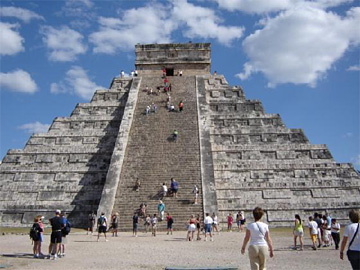
|  |  |  Travel & Outdoors | June 2009 Travel & Outdoors | June 2009  
Mexico's "New Seven Wonders" Win Falls Flat
 Diego Cevallos - Inter Press Service Diego Cevallos - Inter Press Service
go to original
June 30, 2009


| | Chichén Itzá, the most famous Mayan temple city, served as the political and economic center of the Mayan civilization. Its various structures – the pyramid of Kukulkan, the Temple of Chac Mool, the Hall of the Thousand Pillars, and the Playing Field of the Prisoners – can still be seen today and are demonstrative of an extraordinary commitment to architectural space and composition. The pyramid itself was the last, and arguably the greatest, of all Mayan temples. |  |
Mexico City - The Mexican government spent time and money in 2007 to get the Mayan ruins of Chichen Itza declared one of the "new seven wonders of the world" in a contest organised by a Swiss-Canadian businessman. But winning has failed to deliver the desired results.

Two years after the declaration of the winners, which also included the Great Wall of China, the ruins of Petra in Jordan, the Colosseum in Rome, the Taj Mahal in India, the statue of Christ the Redeemer in Rio de Janeiro and the Inca citadel of Machu Picchu in Peru, Chichen Itza has not even received the plaque promised by the foundation that held the contest.

When the competition was over, New Seven Wonders (N7W) failed to keep its promises, the head of the Office of Tourism and Cultural Services (CULTUR) for the southeastern state of Yucatán, Jorge Esma, told IPS.

Chichen Itza, an ancient Mayan city in Yucatán with a number of imposing buildings, was declared a World Heritage Site by the United Nations Educational, Scientific and Cultural Organisation (UNESCO) in 1988.

N7W, headed by Swiss-Canadian Bernard Weber, organised an on-line poll to decide on the "new seven wonders of the world." He promised to provide the winners with funding for conservation projects, but this never happened.

The foundation made a mint and then vanished, Esma said. The Mexican government, for example, spent an undisclosed sum on supporting the nomination of Chichen Itza.

The authorities spared no efforts to publicise the contest, to the extent that Mexican President Felipe Calderón himself appeared on television to urge people to vote.

When the sacred Mayan site was declared one of the seven wonders, the Tourism Secretariat was thrilled. "With this designation, Mexico has a unique opportunity to show the world the grandeur and splendour of Mayan culture, and what the country as a whole has to offer in cultural terms," it said in an information bulletin.

A N7W spokesperson told the newspaper Reforma in the Mexican capital that the contest did not make a profit, and therefore they were not even able to give out the plaques.

The source argued that just by having participated, the winners received a great deal of publicity, and this alone would attract more visitors and revenue.

Before winning the N7W contest, an average of 1.2 million tourists a year visited Chichen Itza. In 2008, the number rose to 1.5 million.

A similar increase in the number of tourists was recorded at other Mexican archaeological sites, like Teotihuacan, near Mexico City, El Tajín in the eastern state of Veracruz, and Tulum on the Caribbean coast in Quintana Roo, none of which were entered in the N7W contest.

The buildings and the main pyramid at Chichen Itza were built by the Maya, probably between the 7th and 10th centuries. It is thought that the city was abandoned around 1250, for unknown reasons.

At the height of its splendour, Chichen Itza covered 25 square kilometres, and was home to an estimated 100,000 people.

When the Spanish reached the city, in the 16th century, it was still a ceremonial centre and a site of pilgrimage for the local indigenous people.

For decades it has been one of Mexico's most popular attractions for local and foreign visitors.

When the N7W contest was held, and the Calderón administration was urging people to vote, columnist Miguel Granados with the Reforma newspaper chided the authorities for their "almost childlike enthusiasm for Chichen Itza to be included on an improbable list of new wonders of the world."

Now N7W is carrying out a new poll, with on-line and telephone voting, to select the top seven natural wonders of the world by 2011. The Sumidero Canyon, in the southeastern state of Chiapas, has been entered for the contest, along with dozens of other places.

The Chiapas state government has said it will invest resources and develop a strategy to try to get the canyon onto the winners' list. |

 |
|  |



